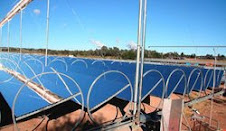Wind turbines gaining power
Smaller communities, colleges plan projects
By Stephanie Ebbert, Boston Globe Staff, via Boston.com
A Lynn waste-water treatment plant could soon get half its power from wind energy. The Massachusetts Maritime Academy is erecting a wind turbine to try to cut its electric bill nearly in half. Hull hopes to save another $500,000 on electric costs, having already powered its streetlights and stoplights for free.
While commercial development of large wind farms continues to stall, Massachusetts municipalities and colleges are increasingly stepping into the void, planning to erect wind turbines one or two at a time to shave their energy costs and take advantage of a state program that rewards green energy producers.
At least a half-dozen Massachusetts cities, towns, or colleges are trying to build wind turbines to temper the rising costs of electricity. Eleven other communities are testing wind conditions to determine whether it would be worthwhile to build wind turbines, and nine more are looking for test tower sites, according to the Massachusetts Technology Collaborative, which is helping communities launch the projects. Thirty-six other municipalities have expressed some interest in wind power, according to the collaborative.
''Any one project will make only a small difference," said Warren Leon, director of the Renewable Energy Trust, a division of the collaborative. ''But if five years from now there are community wind projects up in 15 or 20 communities across the state, collectively that will make a meaningful difference. On average, each project will probably generate enough electricity for close to 1,000 people."
Unlike the offshore wind project proposed for picturesque Nantucket Sound, most of the projects generate only limited opposition, probably because the projects are small and often remote. Hull is planning to build a second wind turbine on a landfill; Lynn, by its waste-water treatment plant; and Ipswich, near a transfer station.
All of the proposals would be dwarfed by the wind farm planned off the Cape and Islands: Cape Wind Associates wants to generate up to 428 megawatts of power, compared to 3.3 megawatts for Orleans' two windmills.
Cape Wind's turbines are proposed at 417 feet tall, compared to the 148-foot turbine the International Brotherhood of Electrical Workers Local 103 built near the Southeast Expressway in Dorchester.
Despite their delays, Cape Wind officials are thrilled to see smaller projects advance, in hope they will lessen fear of the unknown. ''From our standpoint, it's always helpful when wind turbines are erected elsewhere," said spokesman Mark Rodgers. ''Familiarity breeds greater acceptance."
Opponents of the controversial project argue that Cape Wind will always be different because it is proposed offshore and is being developed privately.
''The Cape Wind project is a site that's really driven by the developer to maximize profit, rather than being driven by the public interest," said Audra Parker, assistant director of the opposition group called the Alliance to Protect Nantucket Sound. ''There's a huge difference in scale between these municipally driven projects and the Cape Wind project, which is 24 square miles and 130 turbines."
But wind power can be a moneymaker for municipalities, too: by lowering energy costs, letting municipalities sell excess power, and providing green-energy certificates that communities can sell for profit. The state's Renewable Portfolio Standard calls for utilities to buy 4 percent of their power from renewable sources such as wind by 2009.
At today's rates, a municipality with a single turbine could sell green energy certificates and raise $100,000 a year, Leon said. Some projects also qualify for federal tax credits.
Nationwide, about 100 small-community wind projects have been built, said Kathy Belyeu, a spokeswoman for the American Wind Energy Association. Projects are increasingly being proposed in states that are trying to foster renewable energy, including Iowa, Minnesota, and, more recently, Massachusetts, she said. The collaborative is helping communities test and develop wind power using the renewable energy fund, which is raised by customers' utility fees. The average household pays 20 cents to 30 cents a month into the fund.
In Lynn, the Water and Sewer Commission decided last week to continue pursuing a plan to build a $3 million to $4 million wind turbine, based on projections that the city could start saving roughly $300,000 a year within four to seven years, said Robert Tina, director of operations for the Lynn Waste-water Treatment Plant. The savings would help offset the costs of operating the plant, which serves Lynn, Saugus, Swampscott, and Nahant, he said.
Orleans is working with the collaborative to erect two turbines to create enough energy to power the town's water treatment plant and sell unused green energy to other power companies.
''We have not had opposition," said Kevin Galligan, chairman of the wind energy committee in Orleans. ''The town overall has made a strong commitment to do these right. There are those people that question, 'Is this going to cost the town?' All the questions to date have been helpful."
The Hull Light Department, a municipal power company that built a wind turbine in 2001, is erecting a second in hope of saving $500,000 more on power costs.
Ipswich is asking residents at a spring Town Meeting to invest about $3.8 million in a turbine.
Cape Cod Community College is looking for a new location for a wind turbine, after the Federal Aviation Administration deemed the college's chosen site too close to an emergency flight path.
At the Massachusetts Maritime Academy, a turbine to be built this spring with state funds and a collaborative grant could provide about one-third of the college's electrical load, save $200,000 to $300,000 a year, and introduce engineering cadets to renewable energy, said the college's president, Admiral Richard Gurnon.
''They will see that it is an efficient opportunity to harness a natural resource that will always be available and always be free," Gurnon said. ''For us, it's a two-fer."
Best Green Stocks Investing Blog
Monday, February 27, 2006
Subscribe to:
Post Comments (Atom)
Yuya Joe Blog
Lake Ontario Waterkeeper
The Daily Beast -Politics Blog
21stArch.com - 21st Century Architecture
Original Joe College Blog
WikiLeaks Foreign Policy Analysis
AGreenRealtor.com Real Estate Blog - Ecology Energy Efficiency
Best Green Stocks Investing Blog
PV Intell Photovoltaic Solar Stocks Investing
SEARCH Leading Alternative Energy and Ethical Investing websites

Custom Search
Daily Kos
Rare Earth Stocks Research
Patrick MacManus's Blog Peace and Collaborative Development
BeesTreesFrogsElephants.com - Nature and Ecology Blog
Research Green Energy stocks, Clean Energy investing information
Find wind power investing info online, clean energy mutual funds, geothermal stocks, solar energy investments.

Green Energy Investing Network:
Green Stocks Investing Clean Power Blog
SolarIntell.com Renewable Power Investing Website
Wind Intell.com Wind Energy Stocks Company Links
Geothermal Power Investing Public Companies
PV Intell.com Leading Photovoltaic Solar Energy Stocks

Custom Search
Green Energy Investing Network:
Green Stocks Investing Clean Power Blog
SolarIntell.com Renewable Power Investing Website
Wind Intell.com Wind Energy Stocks Company Links
Geothermal Power Investing Public Companies
PV Intell.com Leading Photovoltaic Solar Energy Stocks







No comments:
Post a Comment